Morning Moon Poses with Planets and Leaves Evenings Dark, Mars Passes Messier 1, Comet Olbers Crosses Coma, and Saturn Sees Double!

This gorgeous image of the Omega Nebula aka the Swan Nebula and Messier 17 in Sagittarius was captured at the Texas Star Party by Trevor Jones. I have rotated it by 90 degrees to better show the swan shape at centre. The image width is double the size of the full moon. The emission nebula is one of the brightest objects in the summer Milky Way and is visible in binoculars under a dark sky. Trevor’s original post about his image is at https://astrobackyard.com/omega-nebula/. Follow his Astrobackyard content on YouTube and other social media sites.
Hello, End-of-August, Stargazers!
Here are your Astronomy Skylights for the week of August 25th, 2024 by Chris Vaughan. Feel free to pass this along to your friends and send me your comments, questions, and suggested topics. You can also follow me on Twitter as @astrogeoguy! Unless otherwise noted, all times are expressed in Eastern Time. To subscribe to these emails please click this MailChimp link.
If you’d like me to bring my Digital Starlab portable inflatable planetarium to your school or other daytime or evening event in Simcoe, Grey, and Bruce Counties, or deliver a virtual session anywhere, contact me through AstroGeo.ca, and we’ll tour the Universe, or the Earth’s interior, together! My book with John A. Read entitled 110 Things to See With a Telescope is a guide to viewing the deep sky objects in the Messier List – for both beginners and seasoned astronomers. DM me to order a signed copy!
The moon will finally leave the evening sky worldwide this week so that we can enjoy the summer Milky Way and its treats, including Comet 13P/Olbers in the western sky as it passes several deep sky objects in Coma Berenices. The inner planets will lurk above the horizon at dawn and dusk, while bright Jupiter, Mars, and Saturn shine on high for long stretches of the night. Mars will pass close to the Crab Nebula, and Saturn will host a double shadow transit. Read on for your Skylights!
The Moon
This is the week of the lunar month that stargazers and Milky Way fans have been waiting for! The moon will spend the week shining in the sky in the wee hours of the morning and then lingering into the morning daylight sky. That will leave the evening and late night skies worldwide extra dark. Unfortunately for those of us in North America, forest fire smoke is still reducing the transparency of the sky. The most affected regions tonight (Sunday) are parts of Montana and North Dakota, Winnipeg and northern Manitoba, Ontario north of Lake Nipissing and north of Elliot Lake plus a thin band extending south through southern Ontario and down into Ohio. The rains of autumn will be a welcome relief for those fighting the fires.
As for the moon, its waning half-illuminated beacon will rise tonight (Sunday) towards 11 pm local time. Once it has cleared the eastern rooftops, it will spend the rest of the night crossing the sky with nearby Uranus and the bright little Pleiades star cluster, aka the Seven Sisters and Messier 45. Binoculars will easily show you the stars of that cluster arrayed to the upper right of the moon. The “sisters” will be farther from the moon for observers viewing them later, or in more westerly time zones. The distant planet Uranus, which is also visible in binoculars, will spend this year about a palm’s width to the right (or celestial SSW) of the Pleiades.
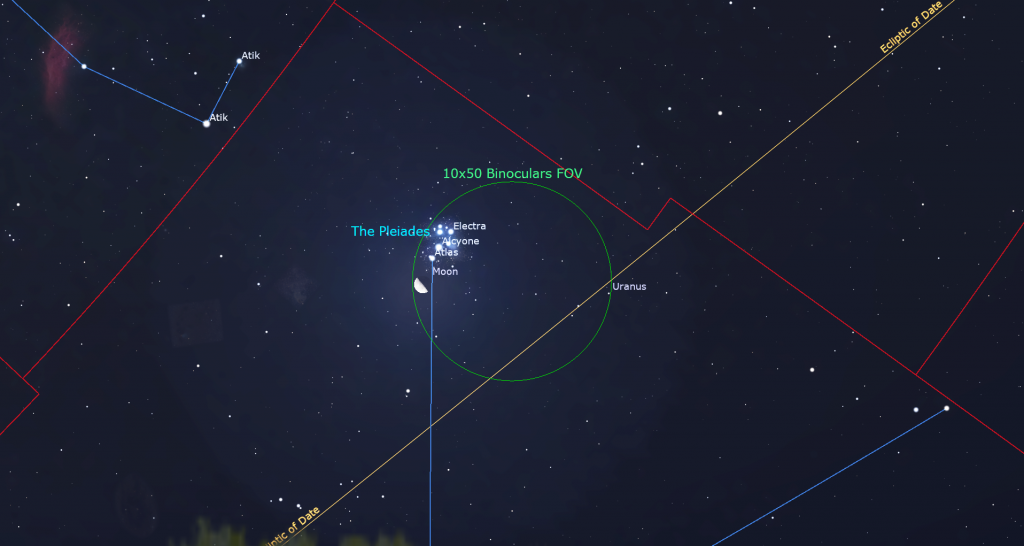
If you stay up late enough, or visit the bathroom during the wee hours (pardon the pun), or rise before dawn on Monday, you’ll also enjoy the sight of winter’s bright stars and the brilliant planet Jupiter with more demure Mars close by. Take a photo! The moon will formally complete three quarters of its orbit around Earth, measured from the previous new moon, on Monday morning at 5:26 am EDT, 2:26 am PDT, or 09:26 Greenwich Mean Time. At its third (or last) quarter phase, the moon appears half-illuminated, on its western, sunward side. It rises around midnight local time, and then remains visible until it sets in the western daytime sky in early afternoon. Third quarter moons are positioned ahead of the Earth in our trip around the Sun. About 3½ hours later, Earth will occupy that same location in space.
As the moon swings continuously sunward through Taurus (the Bull), it will rise about 40 minutes later each night and wane in phase. On Tuesday morning, the pretty, waning crescent moon will shine above the planets Jupiter and Mars in the eastern sky, setting up a nice widefield photo opportunity. Brilliant Jupiter will be unmistakable – almost close enough to the moon for them to share the view in binoculars. The reddish, medium-bright dot of Mars will be positioned a palm’s width to the lower left (or 6 degrees to the celestial east) of Jupiter. Watch for the bright, reddish star Aldebaran, the angry eye star of Taurus, sparkling off to the right of the group. Wednesday morning will be just as picturesque, with the moon then positioned to the lower right of the planets.
The moon will spend Thursday and Friday among the stars of Gemini (the Twins). On Friday morning, the waning crescent moon will form a line below Gemini’s two brightest stars in the eastern sky. Pollux, the lower star is brighter and more yellowish in color than its “twin”, the double star Castor, above it. Even as the sky begins to brighten ahead of sunrise, the bright stars of winter will sparkle off to the right of them.
On Saturday morning, the moon will visit Cancer (the Crab). The big open star cluster known as the Beehive, Praesepe, and Messier 44 will be positioned several finger widths to the moon’s right (or 3 degrees to the celestial southwest). The moon and the cluster, which is more than twice the size of the moon, will be close enough to share the field of binoculars, but you’ll see more of the scattered “bees” if you tuck the moon just out of sight on the left and make your attempt before the morning sky starts to brighten.
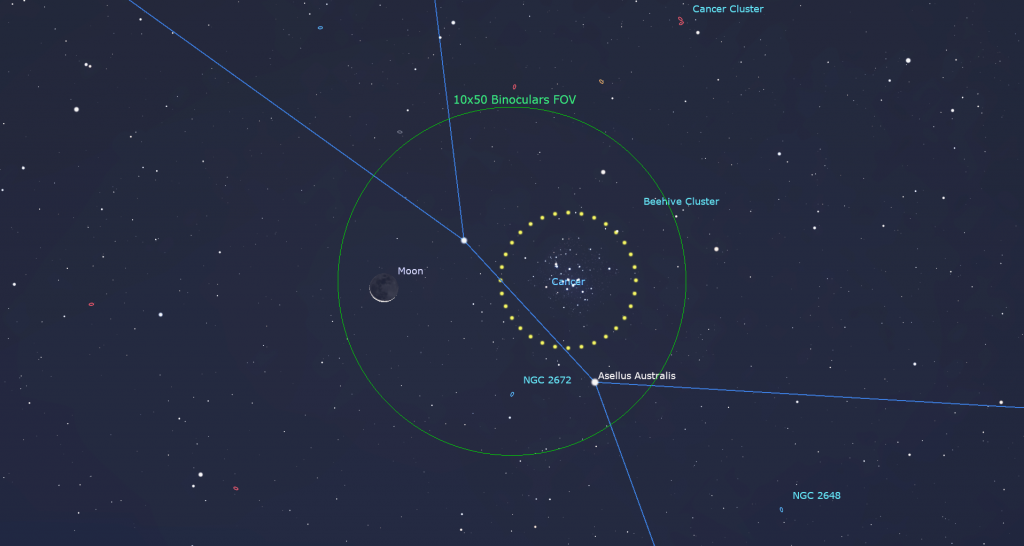
If you are outside before sunrise next Sunday, September 1, you can look for the delicate crescent of the old moon shining several finger widths to the upper left (or celestial north) of the bright speck of Mercury in the eastern sky. The duo, both within the borders of Leo (the Lion), will be proximate enough to share the view in binoculars, but take care to turn all optics away from the eastern horizon before the sun rises. That morning will be a great time to watch for Earthshine on the moon, especially around 6 am local time. Also known as the Ashen Glow and “The old moon in the new moon’s arms”, it is sunlight being reflected off the Earth and back toward the moon, slightly brightening the dark portion of the moon’s Earth-facing hemisphere.
The Planets
Since the morning sky will be so busy this week, let’s start there for the planets.
You won’t have to get up extra early to see swift Mercury. As the planet increases its distance from the sun, it will appear higher in the eastern sky every morning before sunrise, especially later this week. At mid-northern latitudes, the best time to look for it will be around 5:30 to 6 am local time. You’ll need an unobstructed eastern view that is free of clouds and haze. Mercury will be a bright, unmoving dot a short distance above the horizon. (Any white specks that are shifting left or right will be aircraft.) Much brighter Jupiter will gleam far above Mercury. It is safe to use binoculars for your search, but turn them away before the sun rises. In a telescope, Mercury will show a definite crescent shape, though the planet may be blurry or “swimming” due to the extra-thick blanket of atmosphere you will be viewing it through. Remember to check out the gorgeous crescent moon shining near Mercury next Sunday morning. Mercury will be available to enjoy until mid-September.
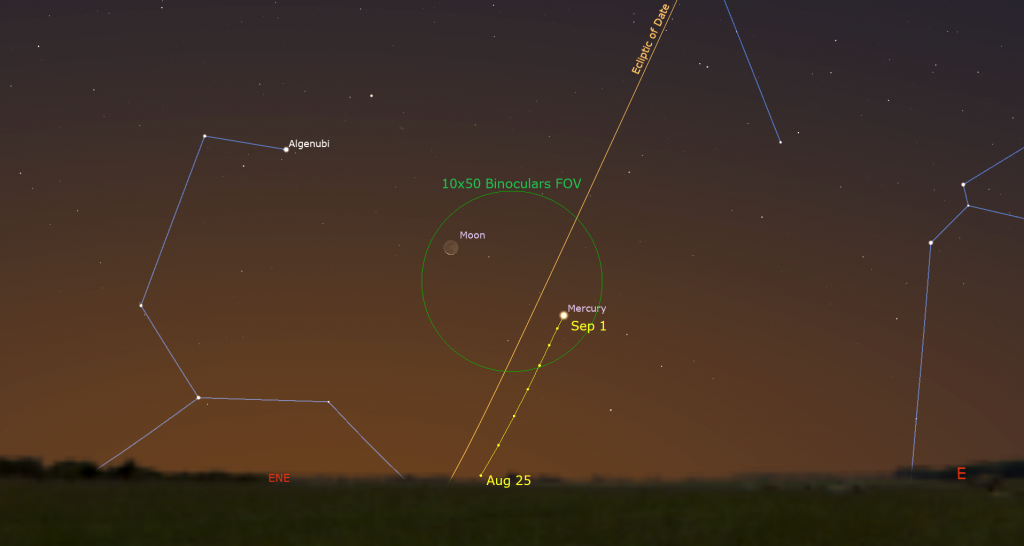
Look up! Mars and Jupiter will also catch your eye in the eastern sky before sunrise. Uranus will be there, too, but it’s harder to identify without binoculars or a telescope.
After Labour Day weekend Jupiter will begin to rise before midnight – kicking off a nine-month stay in the evening sky. Generally speaking, anyone outside between about 1:15 am and sunrise will easily spot the giant planet gleaming as it climbs the eastern sky. The reddish dot of 16 times fainter Mars is positioned to the lower left of Jupiter. Its relatively faster orbital motion will increase its separation from Jupiter each morning. Both planets are shining in Taurus (the Bull), between the critter’s horns about a fist’s width to the left (or 10° to the celestial ENE) of his brightest star, reddish Aldebaran.
Any binoculars will show Jupiter’s four Galilean moons named Io, Europa, Ganymede, and Callisto lined up beside the planet. Those moons complete orbits of the planet every 1.7, 3.6, 7.2, and 16.7 days, respectively. If you see fewer than four moons, then one or more of them is crossing in front of or behind Jupiter, or hiding in Jupiter’s dark shadow – or two of the moons are very close together, or one moon is eclipsing or occulting another one.
Even a small, but decent quality telescope can show you Jupiter’s dark belts and light zones, which are aligned parallel to its equator. With a better grade of optics, Jupiter’s Great Red Spot, a cyclonic storm that has raged for hundreds of years, becomes visible for several hours when it crosses the planet every 2nd or 3rd night. For observers in the Americas, that GRS will cross Jupiter’s disk in the wee hours of Monday, Thursday, and Saturday, and before dawn on Wednesday and Friday morning. If you have any coloured filters or nebula filters for your telescope, try enhancing the spot with them.

From time to time, observers with good quality telescopes can watch the black shadows of the Galilean moons travel across Jupiter’s disk. On Sunday morning, September 1, the black shadow of Europa will travel across Jupiter from 12:11 to 2:39 am EDT (or 04:11 to 06:39 GMT).
Mars will appear about half an hour after Jupiter, and fade from sight before Jupiter does. In a telescope, the red planet will appear as a small, ruddy-coloured disk. Its position on the far side of the sun from Earth is keeping the planet looking small until later this year. If you do check it out, take notice that Mars is only 88%-illuminated because its angle from the sun is 70°. From tonight to Wednesday morning, Mars will travel past the supernova remnant known as the Crab Nebula or Messier 1. At closest approach on Monday and Tuesday, the faint fuzzy patch of the nebula will appear a finger’s width (or 1°) to Mars’ lower right.
Uranus can be enjoyed by night owls or early risers. The planet will rise around 11 pm this week – but it won’t climb high enough for decent views until about midnight local time. In binoculars and a backyard telescope Uranus will appear as a dull, non-twinkling, blue-green star positioned about a palm’s width to the lower right of the bright Pleiades star cluster. The slow-moving distant planet will remain near the Pleiades until 2027!
Switching to the evening sky, we have three planets to peruse.
Although Venus is continuing to increase its angle from the sun every day, it remains stubbornly pinned above the western horizon after sunset for those of us viewing it from mid-northern latitudes. If your western horizon is unobstructed and free of cloud or haze, you can start to look for Venus’ very bright dot starting around 8 pm local time. The planet will be the only bright, star-like object less than a fist’s width above the horizon. Just as with Mercury, if you see a bright speck moving left or right, it’s an aircraft. Wait until the sun has fully set before using binoculars. Folks living closer to the tropics are already easily seeing Venus gleaming between the palm trees after sunset. As we approach the September equinox, she will start to climb higher and become our brilliant “Evening Star” gleaming high in the western sky throughout fall and winter.
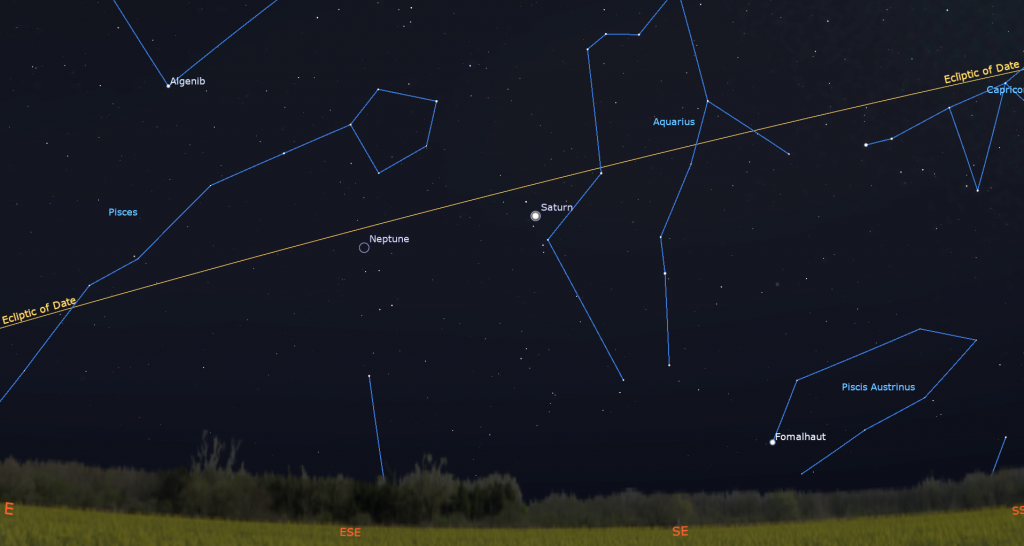
Saturn will shine as a medium-bright speck in the late evening and overnight sky worldwide for many months to come. This week, the ringed planet will rise by about 8:30 pm local time, cross the sky all night, and then shine as a bright “star” in the lower part of the southwestern sky before sunrise. Saturn will spend the next 10 months drifting among the rather faint stars of Aquarius (the Water-Bearer). Binoculars will show you a bent-line trio of stars named Psi Aquarii sparkling to Saturn’s lower right. The lower two are white, while the higher one is golden. Two redder stars named Phi and Chi Aquarii will appear to Saturn’s upper and lower right, respectively.
Saturn’s rings, which will effectively disappear when they become edge-on to Earth next March, already appear as a thick line drawn through the planet’s globe. Good binoculars can hint that Saturn has rings, and any size of telescope will show them and Saturn’s moons! Usually, Saturn’s moons are arrayed all around the planet – unlike Jupiter’s Galileans moons, which are always in a line. But Earth’s perspective of the Saturn system this year and next year will line up its moons with the rings.
Saturn’s largest and brightest moon Titan never wanders more than five times the width of Saturn’s rings from the planet. The much fainter moon named Iapetus “eye-YA-pet-us” can stray up to twelve times the ring width during its 80-day orbit of Saturn. The next brightest moons Rhea “REE-ya”, Dione “Dee-OWN-ee”, Tethys “Teth-EES”, Enceladus “En-SELL-a-dus”, and Mimas “MY-mass” all stay within one ring-width of Saturn.
Titan will move from just above Saturn (or celestial north of it) tonight, stretch far to Saturn’s lower left (celestial east) at midweek, and then to just below the planet (celestial south) on next Sunday night. (Remember that your telescope will probably flip the view around.) The rest of the moons will be tiny specks in a line beyond the rings. You may be surprised at how many you can see through your telescope if you look closely.
Earth’s perspective of the Saturn system will also cause Saturn’s moons and their small black shadows to frequently cross its disk – but you’ll need a very high quality telescope to watch those. Rhea and its shadow will cross Saturn’s southern hemisphere on Friday morning from 1:00 to 3:45 am EDT, and Tethys plus shadow will join them after 2:50 am EDT.
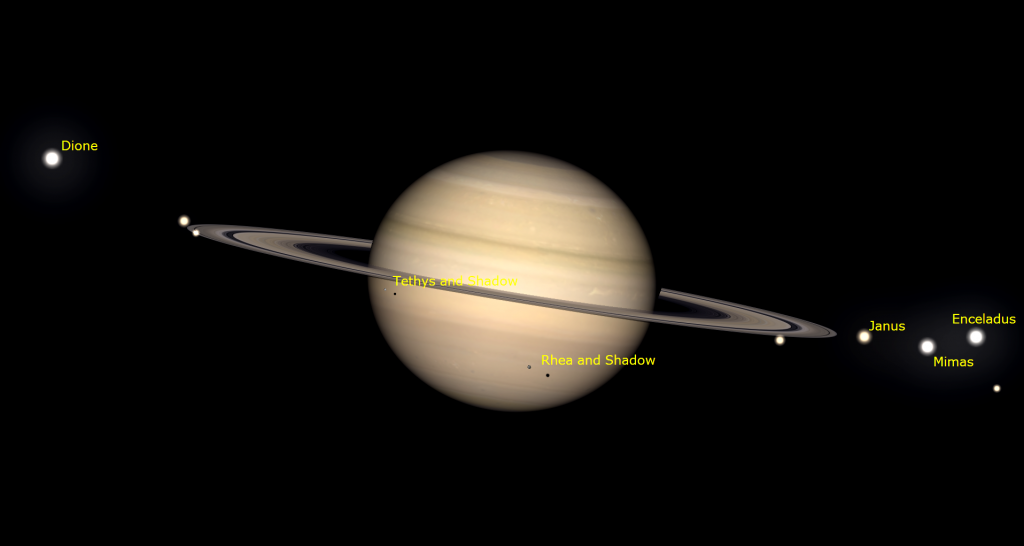
Neptune will rise 20 minutes after Saturn and follow it across the sky every night. The remote, blue planet will be spending this year in western Pisces (the Fishes), a generous fist’s width to the lower left (or 11° to the celestial ENE) of Saturn. Neptune doesn’t move very quickly through the stars. It will be located a bit more than a thumb’s width to the upper left (or 2° north) of a medium-bright star named 27 Piscium, allowing them to share the view in binoculars. Other less-brilliant stars nearby named 29 Piscium, 24 Piscium, and 20 Piscium will help guide you to Neptune with a backyard telescope or good, strong binoculars. For now, the best time to look at Neptune is while it’s higher up and the sky is dark – between about 10 pm and 5:30 am local time.
Comet Olbers
While the moon is absent this week, conditions are good to see a comet named 13P/Olbers from dark sky locations after dusk using large binoculars and backyard telescopes. Comets appear as faint, greyish fuzzballs – sometimes with a slight greenish tint – and sometimes with a tail.
This comet has already passed its peak brightness, but it is currently conveniently positioned in the lower part of the western early-evening sky for mid-northern latitude observers. Recent brightness estimates have been in the magnitude 8.0 range.
This week comet 13P/Olbers will be travelling right-to-left (or celestial southeast) through the faint constellation of Coma Berenices (Berenice’s Hair), which is located in the sky two fist diameters to the lower right of the very bright star Arcturus.

The comet is not going to pass close to any bright stars, but tonight and Monday night it will pass telescope-close above (i.e., north of) a prominent spiral galaxy named Messier 64, aka the Black-Eye Galaxy and NGC 4826. On Friday and Saturday evening, the comet will pass telescope-close above the two bright globular star clusters named Messier 53 and NGC 5053. In both cases, the comet and those deep sky objects will all look fuzzy.
Start your hunt for the comet as soon as the sky gets dark because it will drop too low for decent views after about 9:30 pm local time.
Dark Sky Delights
This week’s moonless nights will offer so much to see. After dusk, the summer Milky Way will rise from the southern horizon beside Sagittarius (the Archer) and then arc overhead through Scutum (the Shield), Aquila (the Eagle), and Cygnus (the Swan). The stars are in the same spot at the same time on the same dates every year – so, rather than burden you with even more reading in these Skylights, I’ll direct you to several of my tours of those constellations and their delights archived at www.astrogeo.ca/skylights. Just ignore any mentions of planets, since they wander about from one year to the next.
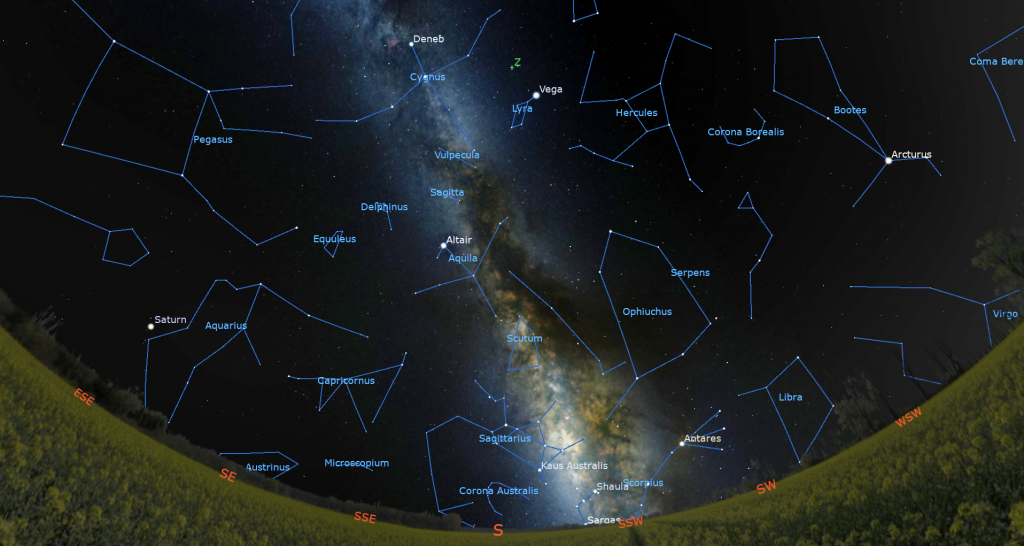
An in-depth look at Lyra (the Harp) is here, the soaring sights of Cygnus (the Swan) are highlighted here, and the gems of Aquila (the Eagle) are described here.
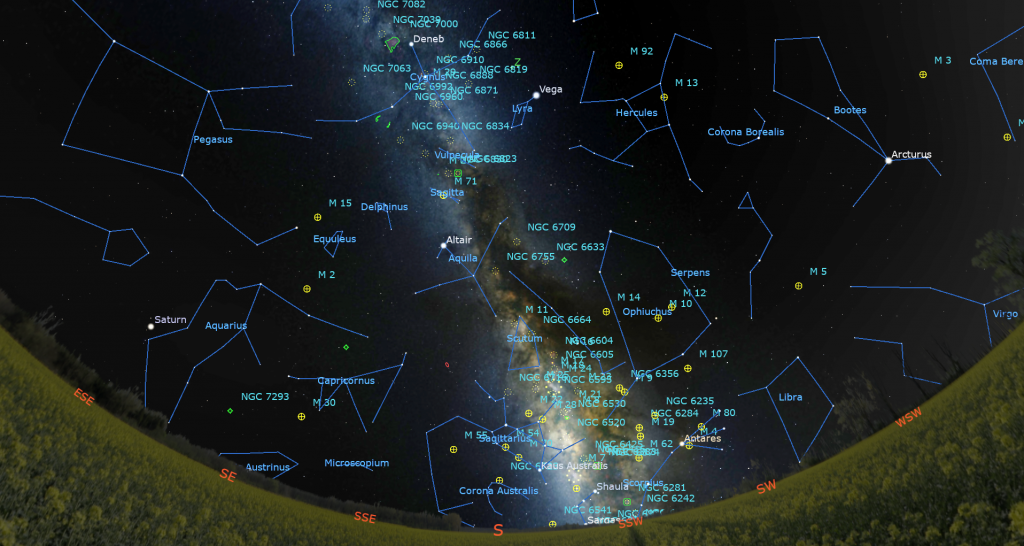
Public Astronomy-Themed Events
Every Monday evening, York University’s Allan I. Carswell Observatory runs an online star party – broadcasting views from four telescopes/cameras, answering viewer questions, and taking requests! Details are here. They host in-person viewing on the first clear Wednesday night each month. Other Wednesdays they stream views online via the observatory YouTube channel. Details are here.
Keep your eyes on the skies! I love getting questions and requests. Send me some!